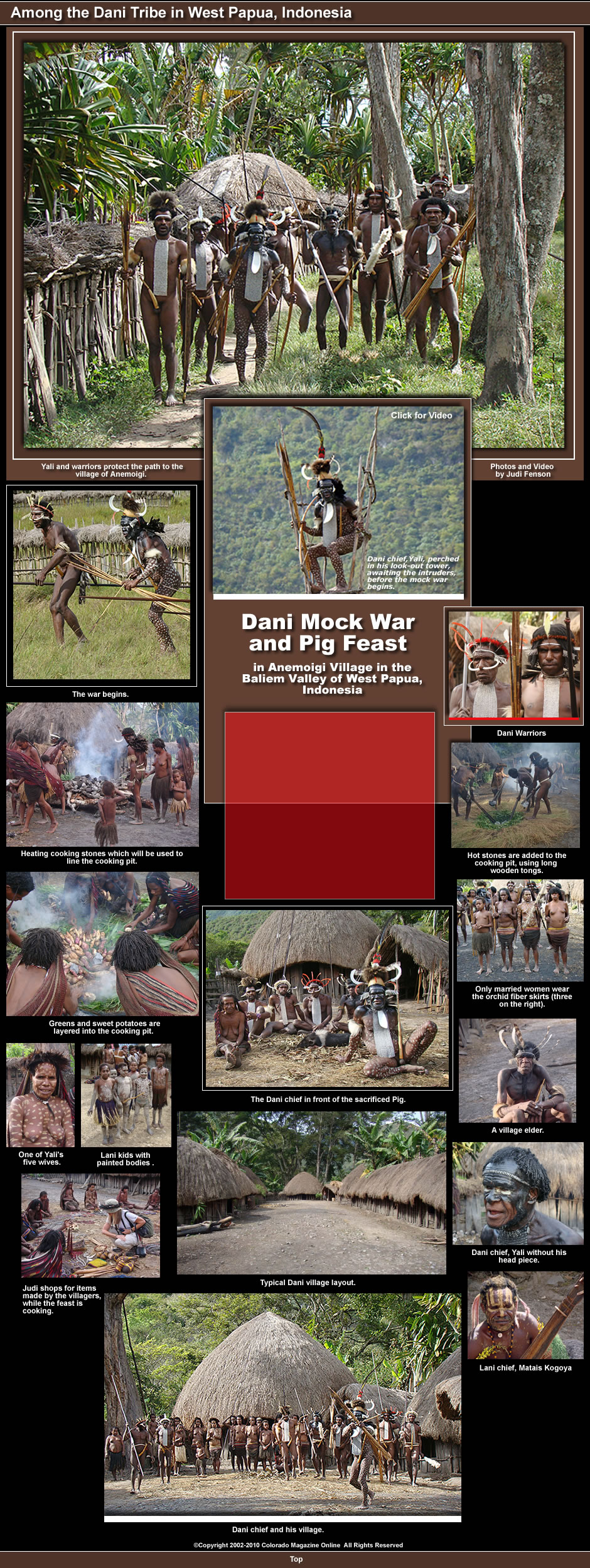

Visiting indigenous tribes that modern society has somehow bypassed holds a special fascination for us. The opportunities to see such groups diminishes each year as tribes loose their native habitats or become corrupted or assimilated by contemporary societies. Some of the best opportunities exist in New Guinea. The independent nation of Papua New Guinea, occupies the eastern two-thirds of the island. The western third is occupied by West Papua, a territory under Indonesian control. West Papua claims the larger number of remote groups.
We had the opportunity to visit a
number of villages of two different tribes living in the Baliem Valley of
West Papua – the Dani and the Lani. We witnessed a colorful traditional
ceremony in September 2008 in a village of the Dani people. The Dani live
in widely separated villages of 50 or fewer individuals. The round, thatched
dwellings are arranged in an oval design. Each consists of a men’s house,
a women’s house, a cooking house, and quarters for the pigs that play
a central role in the lives of the Dani. The men wear nothing except a gourd
(koteka) over their penis. Tobacco and valuables are also kept in the gourd.
The women traditionally wear only a short skirt and a woven bag to cover their
backs
The main work of the Dani is tending their gardens, cultivating 70 varieties
of sweet potatoes, the mainstay of their diet, supplemented by a few other
vegetables, greens and bananas when available. Pigs, the only source of protein,
play a central role in Dani culture, defining wealth. Pigs are only sacrificed
on ceremonial occasions but these occur often enough to ensure that a little
meat is consumed at least bi-weekly. Hunting is uncommon because there is
so little game.
Tools and weapons are fashioned from local resources: wood, stone, bone, vines,
roots and bamboo. The villages have no modern features at all - no electricity,
no toilet facilities, no furniture.
Men often insert pig tusks through
their noses. For important ceremonies, the Dani create patterns on their bodies
with pig grease, soot, clay, and mud. Both men and women adorn themselves
with feathers shells, flowers, and leaves.
Mock battles and pig feasts are important rituals associated with major events
such as marriages and deaths. Mock battles replace bow and arrow battles between
villages that occurred on a regular basis prior to Indonesian control. While
fatalities were reportedly uncommon, these skirmishes are now banned.
As we approached Anemoigi village, the chief was at the top of a lookout tower, watching for us. His warriors concealed themselves in the high grass. Thus began an absorbing 4-hour ritual where we felt like we were walking through the pages of a century-old National Geographic.
After we (the enemy) were spotted,
a mock war ensued. Two groups of warriors decorated in war paint, threatened
and charged one another with long spears and bow and arrows, shouting and
chanting. The warriors then turned their attention to us, symbolically guarding
their village while threatening us. Finally we were invited into the village
and preparations began for the pig feast.
A cooking pit was dug and lined with greens. A fire started with friction
burned a pile of wood, heating stones that were used to cook a pig that had
been shot with a bow and arrow. Sweet potatoes and greens were added along
with water to produce steam.
When the feast was ready, in separate
groups, the men mostly ate the meat while the women ate the entrails, sweet
potatoes and greens. The chief offered us half of the meat. We accepted a
small amount but our guide Adreas advised against eating the undercooked meat.
Our chef Otis, later cooked the meat more thoroughly and served it with our
dinner. We passed it along to our porters.
We came hoping to observe an indigenous culture largely frozen in time. And
that’s pretty much what we found. Some of Dani villages are within walking
distance of Wamena and some villagers spend time in town. Despite their interaction
with visitors, the Dani remain true to their traditional lifestyle and remarkably
similar to patterns described by the landmark Harvard - Peabody expedition
in 1960.
Note: Wamena, the main Baliem Valley town, is reached by air from the capital city of Jayapura, which is in turn reachable from the Indonesian islands of Bali (Denpasar) or Java (Jakarta). Grand Irian Tours and Travel did a great job of arranging this trip for us.
 |
|